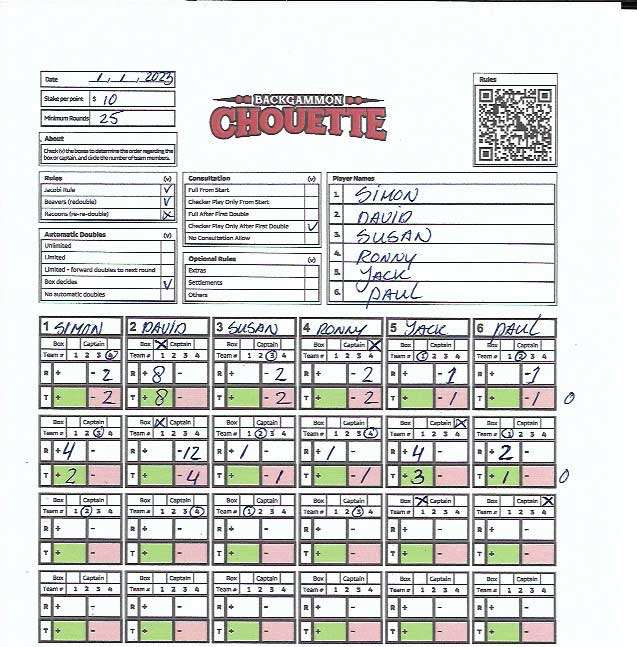How does a backgammon chouette score sheet work, and how should I fill it out? A backgammon score sheet is essential to keep track of the score during a game of backgammon chouette. The score per player changes after each round. In this article, we will explain how to fill out the score sheet and how to verify the score after each round. If you are not yet familiar with the rules of backgammon chouette or how the player rotation works in Backgammon Chouette, we advise you to read those pages first.
The Backgammon Chouette Score Sheet
Download the score sheet to play Backgammon Chouette here directly for free. The Scoresheet is divided into two files, the front and the back.
And here is the back of the scoresheet.
Note: This scoresheet is designed to be printed double-sided and is suitable for up to 6 players. If you want to play with more than 6 players, you can use an additional scoresheet and attach it to the right side of the original scoresheet.
How to use the Chouette Score Sheet?
Before you start playing, fill in the name of each player and the relevant rules. To begin, all players should agree on the “stake per point” and the minimum number of rounds to be played. Additionally, you need to make agreements regarding “consultation,” “automatic doubles,” “beavers and raccoons,” and any other supplementary rules, such as settlements or extras. You can enter all this information at the top. For better clarity, you can also write the names above each column.

The sheet is organized so that each player has a column with blocks. Column 1 is for player 1, column 2 is for player 2, and so on, with player 6 on the far right. Each block represents one game or playing round.
Keeping track of the Player Rotation Order
For each playing round, you need to keep track of who is the Box, the Captain, and the order of the team members. You can easily do this by placing a checkmark in the box behind “Box” for the player designated as the Box. Similarly, for the Captain, you can circle the player’s order number if they are a team player. If a player is the first in line after the Captain, you would circle number 1.
Keeping track of the Score
For each player, you need to fill in 2 scores per round, representing the outcome of that specific round. You record this information in one of the blocks behind the letter “R” for round, marked with “+” and “-“. If the player wins points, you fill in the block with a “+”. If the player loses points, you fill in the block with a “-“.
For each player, you also keep track of the cumulative total score per round. This is noted in the row labeled with the letter “T,” using colored blocks with “+” and “-“.
To keep track of the cumulative score per round, if a player wins, you add the points earned in the respective round to the calculated total of the previous round. If a player loses points in the respective round, you subtract the points of that round from the calculated total of the previous round.
Verifying the Score
To ensure the accuracy of the scores per round, you can easily calculate the sum of the “total row” for each round. This sum should always be 0.
Definition of Terms
- Box: The player who plays alone against the Captain and his team.
- Captain: The Captain is the player of the team, the only team member who is allowed to touch the checkers, and has the final decision on the moves to make.
- Beavers: Instant redouble when you receive a Double while holding the Cube.
- Raccoon: When you get “Beavered” you have the option to redouble again without getting possession of the Cube.
